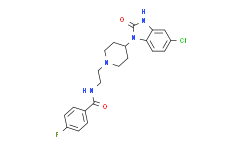| Cas No.: | 59831-65-1 |
| Chemical Name: | Halopemide |
| Synonyms: | Halopemide;N-[2-[4-(5-chloro-2-oxo-3H-benzimidazol-1-yl)piperidin-1-yl]ethyl]-4-fluorobenzamide;5-chloro-1-{1-[2-(4-fluoro-benzoylamino)-ethyl]-piperidin-4-yl}-1,3-dihydro-benzoimidazol-2-one;Halopemida;halopemide ( N-<2-<4-(5-chloro-2-oxo-1-benzimidazolinyl)piperidino>ethyl>-p-fluorobenzamide );Halopemidum;N-(2-(4-(5-Chloro-2-oxo-1-benzimidazolinyl)piperidino)ethyl)-p-fluorobenzamide;N-2-[4-(5-chloro-2,3-dihydro-2-oxo-1H-benzimidazol-1-yl)-1-piperidinyl]ethyl-4-fluoro benzamide;R 34,301 |
| SMILES: | FC1=CC=C(C(NCCN2CCC(N3C(=O)NC4=CC(=CC=C34)Cl)CC2)=O)C=C1 |
| Formula: | C21H22ClFN4O2 |
| M.Wt: | 416.876387119293 |
| Purity: | >98% |
| Sotrage: | 2 years -20°C Powder, 2 weeks 4°C in DMSO, 6 months -80°C in DMSO |
| Description: | Halopemide is a potent phospholipase D (PLD) inhibitor, with IC50s of 220 and 310 nM for human PLD1 and PLD2, respectively. Halopemid is a dopamine receptors antagonist, and acts a psychotropic agent[1][2]. |
| Target: | PLD1:220 nM (IC50) PLD2:310 nM (IC50) dopamine receptors |
| In Vivo: | Halopemide (10 mg/kg; p.o.) induces dyskinesias in the majority of monkeys tested[2]. |
| In Vitro: | Halopemide (1-2 μM; 21 day) affects calcification in transdifferentiated MOVAS cells[3]. |
| References: | [1]. Scott SA, et al. Design of isoform-selective phospholipase D inhibitors that modulate cancer cell invasiveness. Nat Chem Biol. 2009 Feb;5(2):108-17. [2]. Neale R, et al. Acute dyskinesias in monkeys elicited by halopemide, mezilamine and the "antidyskinetic" drugs, oxiperomide and tiapride. Psychopharmacology (Berl). 1981;75(3):254-7. [3]. Skafi N, et al. Phospholipase D: A new mediator during high phosphate-induced vascular calcification associated with chronic kidney disease. J Cell Physiol. 2019 Apr;234(4):4825-4839. |

 To enhance service speed and avoid tariff delays, we've opened a US warehouse. All US orders ship directly from our US facility.
To enhance service speed and avoid tariff delays, we've opened a US warehouse. All US orders ship directly from our US facility.




















